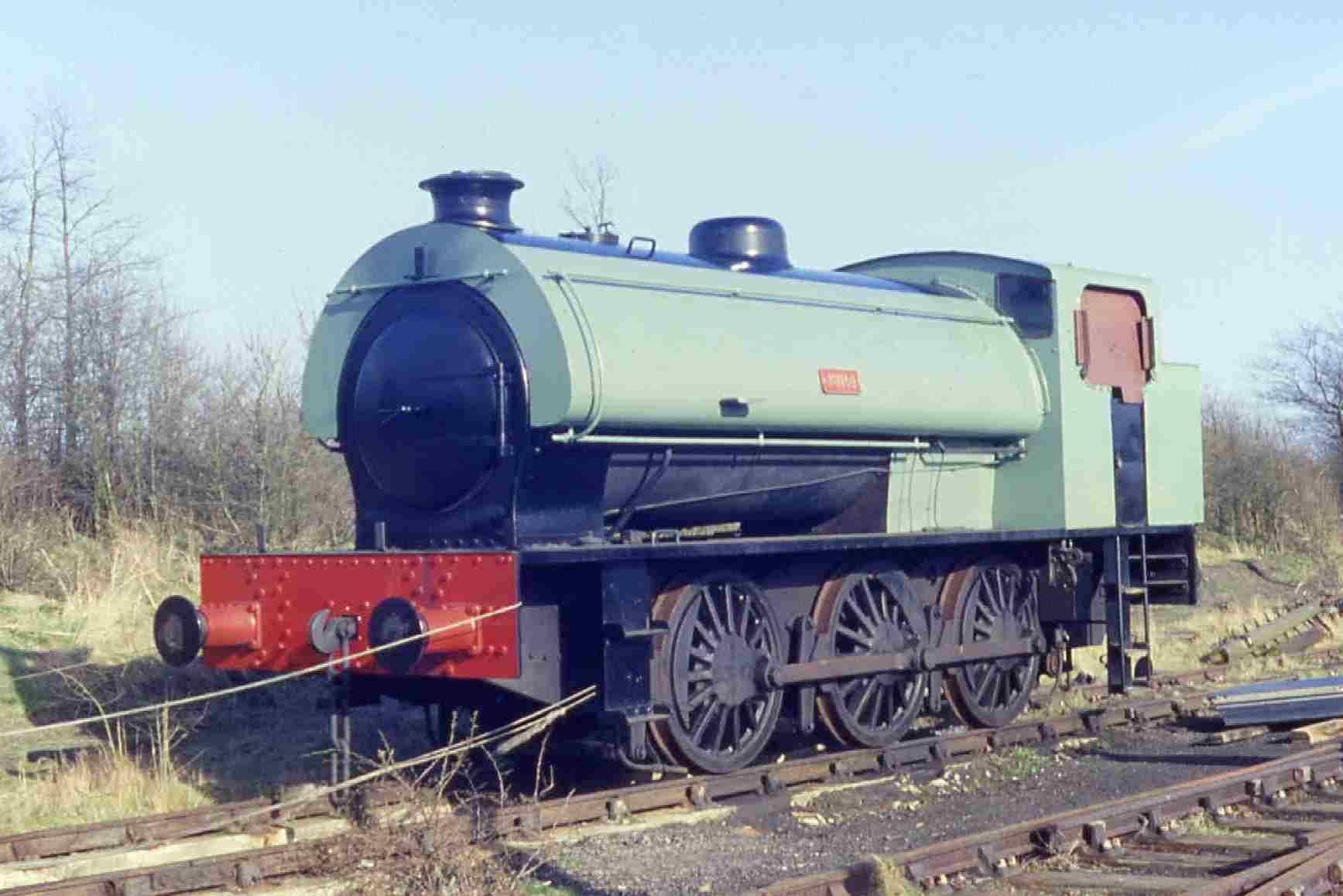
BRC Website Home
Quainton Virtual Stockbook - Glossary
Austerity Locomotives

BRC Website Home
Quainton Virtual Stockbook - Glossary
Austerity Locomotives
|
Introduced by Hunslet in 1943 these locomotives were based on designs from as far back as the 1920s. They were built to fulfil an order from the Ministry of Supply, some 300 machines being built in three years. Not all were built by Hunslet though, Robert Stephenson and Hawthorn, Bagnall, Barclay, Hudswell Clarke and Vulcan Foundry also being involved. It was because of the association with the war effort that the class became known as Austerities. The nickname Bed Iron has also being applied because of the connections with wartime scrap metal drive during which metal bed frames, fences, pots and pans etc., were melted down to provide steel for industry. After the war construction continued for industrial users, sixty were also sold by the MoS to the LNER who classified them J94. The last batch of 'Austerities' were built in 1964, the engines being fitted with mechanical stokers, rocking grates and special drafting arrangements. The Clean Air Act, 1956, placed on the users of boilers certain obligations where the regulations applied. For instance, the emission of dark smoke was prohibited except in specific circumstances, and practical measures had to be taken to prevent the discharge of grit and dust from boiler plant burning more than 1 tom of fuel per hour. Coincidentally with the introduction of this legislation the availability and cost of suitable grades and qualities of coal for locomotive purposes became lower. Thus a stimulus existed for fresh thinking on the problem of reducing smoke from railway locomotives, for a reconsideration of the use of poorer types of coal, and simultaneously, for the general improvement in the thermal efficiency and the flexibility of operation of the traditional steam locomotive. The new designs to achieve these objectives were prepared by the Hunslet Engine Co., Leeds and were applied to a number of NCB 0-6-0ST's built to Hunslett's design. Three were converted in 1961; two in 1962: three in 1963 and about twelve more were converted, or built new, as indeed was No. 66, in 1964/65. Externally the engines are easily recognisable by the design of chimney cowl which was adopted when the smoke box arrangements were modified but the major alterations were internal, and were all developed to be an integral part of the overall concept. There were four parts to the new system. The first part is fitted to No. 66 and it is an underfeed stoke comprising a reciprocating steam engine driving a trough and feeder assembly which is located under the cab floor. Coal is gravity fed to the trough and it travels along the stoker to the final feed to the grate where the fuel is spread to give a hot thick fire at the back and sides of the firebox. In the Hunslet design there is a rocking grate with a drop section in the centre forward part. This allows the ash to move by gravity towards the front where it can be dropped into the ash pan by manual operation of a rocking lever. At present, No. 66, was a conventional grate which was fitted for use at Cadeby Colliery, where very small slack coal was used which would have been unsuitable for the rocking and drop grate. A ¾ inch square steel plate bolted to the rear buffer beam protects the valve gear of the stoker engine from damage by a swinging coupling hook or obstruction on the track. The second part of the system is the gas producer system. When air passes upwards through a fuel bed, as in a locomotive firebox, combustion takes place, and the carbon in the fuel may be completely burnt in one stage to carbon dioxide. Normally there is partial combustion and a mixture of carbon dioxide and carbon monoxide is produced. These gases, with any unused oxygen and all the nitrogen from the primary air, are collectively called producer gas. Combustion continues in the firebox space, sometimes with the addition of secondary air through the firebox door. The operation of a locomotive demands heat from a wide range of rates of combustion. Ideal or optimum combustion with the minimum production of smoke is achieved with frequent and small additions of fuel to an incandescent evenly burning fire bed, but inferior fuel, especially coal with a high ash content with ash having a low fusion temperature, soon gives a choked grate. Heavy firing also creates conditions of incomplete combustion with thick black smoke and pollution and inefficiency. These problems and others associated with a steam locomotive firebox are dealt with by the Hunslett gas producer, jet turbulence and secondary air arrangements. The gas producer system seeks to avoid choking the grate with fused ash or clinker by simply cooling the ash with steam. This serves a dual purpose by cooling the ash and simultaneous making water gas; a mixture of hydrogen, carbon monoxide and carbon dioxide from the steam, which enriches the producer gas formed in the fuel bed. The steam comes from the steam cylinder of the stoker engine, also from exhaust steam from the locomotive, the latter being proportional to the work being done by the locomotive, automatically controlled by the setting of regulator. The relatively cool fuel bed permits the use of smaller coal down to ½in singles and reduces fuel costs. The driver can control the 'live' steam as required to eliminate clinkering. The burning gases above the fuel bed are given ideal combustion conditions in the Hunslett firebox by the introduction of a special high thermal capacity refractory arch which is positioned to ensure the fullest possible travel of the gases in the firebox. The jet system introduces additional turbulence in the firebox, a real necessity if smoke is to be avoided when working the engine hard with a heavy blast or when the locomotive is lit up and the fire is relatively cold. This system comprises a number of steam jets and ports through secondary air can be induced into the firebox to create forward flow of burning gases over the surface of the fire and the back up under the arch before they pass forward into the boiler tubes. The efficiency of the system is promoted by drawing the secondary air for the jets from the ash pan and using some preheat from this source. When the engine is lit up from cold, steam or compressed air from an external supply can be used for the jets. If the locomotive is standing. The steam jets are excellent to use to create turbulence in the firebox so as to eliminate the production of smoke even with these difficult conditions after firing fresh coal. Thus, the third modification, the jet system, is available under all working conditions from light up to heavy working. The fourth part of the Hunslet modifications are in the smoke box. The conventional means of producing partial vacuum in a locomotive smoke box to create draught is improved by adopting the Kylpor arrangement of aerodynamically efficient quantity of steam. The Kylpor exhaust is derived from the Kylchap assembly extensively incorporated into French steam locomotive practice by M. Chapelon and used by Sir Nigel Gresley on Mallard and four other A4 Pacifics in 1938 and to the remainder of the class in later years. Basically it consists if a casting mounted onto the cylinders to establish streamlined exhaust flow and give a major reduction in exhaust back pressure. There are two stages of induction for smoke box gases, one immediately above the exhaust flow straightener and the other above the shaped multi-duct unit mounted on it. The chimney is brought down well below the horizontal centre line of the smoke box, similar to a Giesl ejector and the petticoat pipe is flared over the discharge of the multi-duct flow unit. Advantage is taken of the arrangement to incorporate the blower into the system to make use of the same aerodynamic flow design and to benefit from the economies in steam. One other adjustment is included in the Hunslet design and this is called a smoke box tuning device. It consists of a variable opening on the smoke box door so that the draught can be matched to the type of fuel used. In 1963 one of the 18in Austerity 0-6-0ST's built by Hunslet's for the War Department in 1943, maker's No. 2868 was rebuilt with the underfeed stoker, gas producer and Kylpor blastpipe. In April it was tested on the Western Region from Oxford shed using the Western Region dynamometer car, DW150192, from the Chief Electrical and Mechanical Engineer's department Swindon. On 23rd April it was noted passing Kingham; on the 26th it was at Oxford MPD and on the 28th it was in Swindon works. The results of the trials were not made generally available, but the advantages of the conversion were quite clear and many NCB locomotives were so dealt with. Reference: |
Examples at Quainton |
|
 |
Hunslet Austerity 0-6-0ST No. 3890 (NCB66) |
Examples Previously at Quainton |
|
 |
Hunslet Austerity 0-6-0ST No. 3850 Juno |
 |
Hunslet Austerity 0-6-0ST No. 3889 |
Text © Quainton Railway Society / Photographs © Quainton Railway Society or referenced photographer
Email Webmaster
Page Updated: 14 October 2017